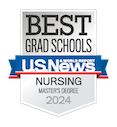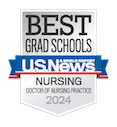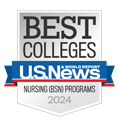U-M School of Nursing enjoyed a strong presence at this year's National Association of Pediatric Nurse Practitioners Conference.
 On March 28 through 31, a record number of attendees gathered in San Antonio, Texas, for the 33rd Annual National Association of Pediatric Nurse Practitioners (NAPNAP) Conference. Among those who attended were School of Nursing Associate Professor and Chair of the Division of Health Promotion and Risk Reduction Dr. Kristy Martyn, Clinical Assistant Professor Dr. Donna Marvicsin, Research Fellow Dr. Cynthia Danford, and Clinical Instructor Kristin Stevens. Dr. Gary Freed, a professor of pediatrics at the U-M Health System, also attended, along with a number of School of Nursing students, including Heather Grossklaus, Jade Curry Burns, and U-M PNP graduates Stephanie Pritula and Amy Arnett.
On March 28 through 31, a record number of attendees gathered in San Antonio, Texas, for the 33rd Annual National Association of Pediatric Nurse Practitioners (NAPNAP) Conference. Among those who attended were School of Nursing Associate Professor and Chair of the Division of Health Promotion and Risk Reduction Dr. Kristy Martyn, Clinical Assistant Professor Dr. Donna Marvicsin, Research Fellow Dr. Cynthia Danford, and Clinical Instructor Kristin Stevens. Dr. Gary Freed, a professor of pediatrics at the U-M Health System, also attended, along with a number of School of Nursing students, including Heather Grossklaus, Jade Curry Burns, and U-M PNP graduates Stephanie Pritula and Amy Arnett.
NAPNAP serves as the nation’s primary group for pediatric nurse practitioner (PNP) practice and education. This year’s conference addressed a broad array of topics pertinent to child healthcare, such as childhood obesity, behavioral and developmental screening, pharmacology, bullying, breastfeeding, and more. While the talks and poster sessions at the conference covered a variety of issues, they all shared a common focus central to NAPNAP’s mission: to improve access to quality child healthcare.

Each of the U-M faculty in attendance presented at the conference. Dr. Marvicsin and co-author Dr. Danford led a well-attended session on childhood obesity prevention research, a topic of priority not only to the conference but to national child healthcare in general. Their innovative work in promoting healthy lifestyles in children generated great interest among those who listened to their talk.
In a related session, Dr. Danford, co-author Dr. Martyn, and nursing doctoral student Celeste Schultz delivered a poster presentation on the prevention of childhood obesity. Their work utilizes event history calendars as a history-taking tool and as a way for children and parents to recollect and reflect on factors like nutrition and physical activity. Dr. Martyn reported that their presentation was met with much interest and discussion, as well, affirming the research’s potential for influencing practice and preventing childhood obesity.
Also in attendance at the NAPNAP conference was Dr. Loretta Ford, considered to be the founder of the nurse practitioner movement. “Dr. Ford was a tremendously vibrant speaker,” said Dr. Martyn. Dr. Ford’s presentation addressed decreasing barriers to advanced practice. At the talk, she urged PNPs to strategically engage partners across professions in the effort to improve child healthcare.

On the final morning of the conference, a panel led by U-M faculty, NAPNAP, and the
Pediatric Nursing Certification Board (PNCB) leaders focused on increasing access to child healthcare and reemphasized Dr. Ford’s call to action. In addition to Dr. Martyn, the panel included Dr. Freed and Kelly Dunham; Dr. Jean Martin, past president of NAPNAP; and Dr. Sarah Gutknecht, president of the PNCB.
As representatives from a variety of organizations involved in child healthcare, the panel was able to present diverse yet collaborative perspectives on the topic under discussion: the PNP workforce.
The issue of the PNP workforce has recently received attention in the pediatrics community after the publication of workforce surveys conducted by Dr. Freed and the
Child Health Evaluation and Research Unit (CHEAR), a multidisciplinary research unit at the University of Michigan. The
American Academy of Pediatrics board commissioned Dr. Freed and CHEAR to study the PNP workforce in order to confirm the assumption that NPs will be able to help meet the access to child healthcare needs in the country. Dr. Martyn and School of Nursing Professor Emerita Dr. Carol Loveland-Cherry were also involved in carrying out the survey, and co-authored the report of the findings, which was later published in
Pediatrics.
As a result, the co-authors collaborated with NAPNAP and PNCB to conduct a survey focused on why PNPs choose to go into pediatric advanced practice nursing. The results of the survey were presented by the NAPNAP Conference panel. “We found that there actually aren’t enough PNPs to meet the child healthcare needs in the country,” said Dr. Martyn. “This means we need more students to go into pediatric advanced practice academic programs.” Most significantly, she saw the survey by CHEAR and the panel discussion as exemplifying Dr. Ford’s message. “It provided an opportunity to engage in partnership together,” she said, “with the main point being creating access to child healthcare.”
Other highlights of the conference included the meeting of the Association of Faculties of Pediatric Nurse Practitioners (AFPNP), a group of which Dr. Martyn, Dr. Marvicsin, and Dr. Danford are members. At the meeting, Dr. Marvicsin was nominated to run as a member of the AFPNP board. U-M faculty enjoyed further accolades when Dr. Danford received the AFPNP Excellence in Research Award at the NAPNAP Awards ceremony.
Dr. Martyn noted the impressive Michigan presence at this year’s conference, thanks not only to the attendees from U-M but also from the overall strong showing from the
Michigan NAPNAP Chapter. The president, president-elect, and secretary—U-M’s Dr. Danford— and many members were all present at the conference. “Michigan is extremely well-represented in this influential group,” said Dr. Martyn.
 On March 28 through 31, a record number of attendees gathered in San Antonio, Texas, for the 33rd Annual National Association of Pediatric Nurse Practitioners (NAPNAP) Conference. Among those who attended were School of Nursing Associate Professor and Chair of the Division of Health Promotion and Risk Reduction Dr. Kristy Martyn, Clinical Assistant Professor Dr. Donna Marvicsin, Research Fellow Dr. Cynthia Danford, and Clinical Instructor Kristin Stevens. Dr. Gary Freed, a professor of pediatrics at the U-M Health System, also attended, along with a number of School of Nursing students, including Heather Grossklaus, Jade Curry Burns, and U-M PNP graduates Stephanie Pritula and Amy Arnett.
On March 28 through 31, a record number of attendees gathered in San Antonio, Texas, for the 33rd Annual National Association of Pediatric Nurse Practitioners (NAPNAP) Conference. Among those who attended were School of Nursing Associate Professor and Chair of the Division of Health Promotion and Risk Reduction Dr. Kristy Martyn, Clinical Assistant Professor Dr. Donna Marvicsin, Research Fellow Dr. Cynthia Danford, and Clinical Instructor Kristin Stevens. Dr. Gary Freed, a professor of pediatrics at the U-M Health System, also attended, along with a number of School of Nursing students, including Heather Grossklaus, Jade Curry Burns, and U-M PNP graduates Stephanie Pritula and Amy Arnett.  Each of the U-M faculty in attendance presented at the conference. Dr. Marvicsin and co-author Dr. Danford led a well-attended session on childhood obesity prevention research, a topic of priority not only to the conference but to national child healthcare in general. Their innovative work in promoting healthy lifestyles in children generated great interest among those who listened to their talk.
Each of the U-M faculty in attendance presented at the conference. Dr. Marvicsin and co-author Dr. Danford led a well-attended session on childhood obesity prevention research, a topic of priority not only to the conference but to national child healthcare in general. Their innovative work in promoting healthy lifestyles in children generated great interest among those who listened to their talk. On the final morning of the conference, a panel led by U-M faculty, NAPNAP, and the Pediatric Nursing Certification Board (PNCB) leaders focused on increasing access to child healthcare and reemphasized Dr. Ford’s call to action. In addition to Dr. Martyn, the panel included Dr. Freed and Kelly Dunham; Dr. Jean Martin, past president of NAPNAP; and Dr. Sarah Gutknecht, president of the PNCB. As representatives from a variety of organizations involved in child healthcare, the panel was able to present diverse yet collaborative perspectives on the topic under discussion: the PNP workforce.
On the final morning of the conference, a panel led by U-M faculty, NAPNAP, and the Pediatric Nursing Certification Board (PNCB) leaders focused on increasing access to child healthcare and reemphasized Dr. Ford’s call to action. In addition to Dr. Martyn, the panel included Dr. Freed and Kelly Dunham; Dr. Jean Martin, past president of NAPNAP; and Dr. Sarah Gutknecht, president of the PNCB. As representatives from a variety of organizations involved in child healthcare, the panel was able to present diverse yet collaborative perspectives on the topic under discussion: the PNP workforce. 




